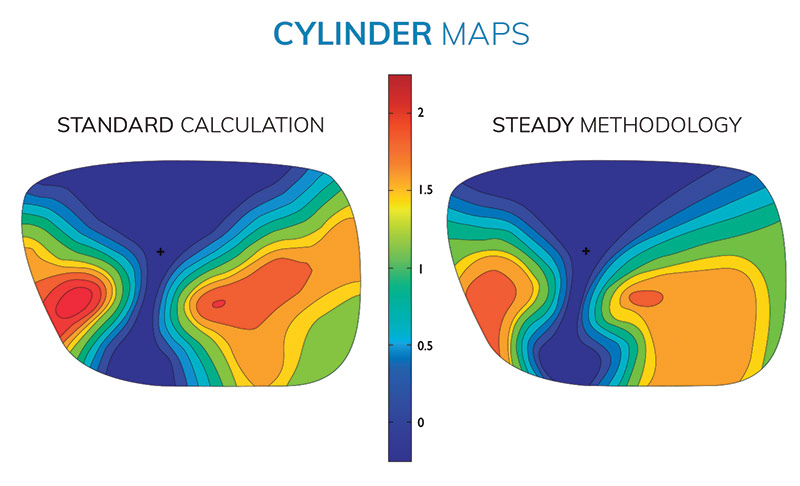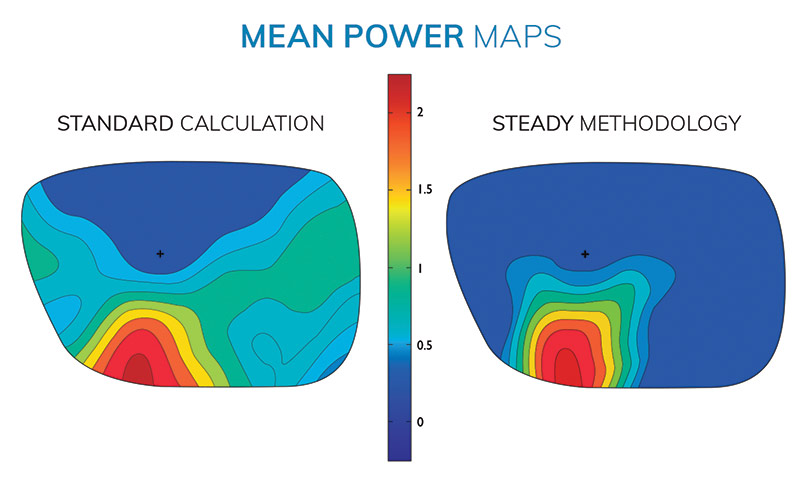Sponsored by IOT
By Deborah Kotob, ABOM
Digital personalization of lenses allows for design optimization that accommodates the position of wear parameters. This customization of the lens design has significantly decreased lateral distortions improving optical performance and wearer satisfaction rates.
Despite these advances in progressive lens design technology, some patients still experience the swim effect, especially in dynamic conditions. New Steady Method technology uses new data on optimum power distribution of mean spherical power to reduce the swim effect, while still optimizing the lens for unwanted astigmatism. Addressing both the mean spherical power and unwanted astigmatism in the lateral areas of the lens further reduces distortions while expanding useable areas. The result is more stable vision and more expansive clear fields of view.
There are geometrical limitations in progressive lens design described by the Minkwitz theorem that make it impossible to design a progressive lens (PAL) with zero peripheral distortion. Therefore, the goal of most progressive lens designers is to minimize these distortions to their geometrical limits. The addition power build or rate of progression results in spherocylindrical peripheral distortion laterally, on either side of the progressive corridor. Yet traditionally, design improvement efforts only target the reduction of astigmatic (cylindrical) distortion.
Based on empirical evidence, IOT Steady Method design technology goes one step further and takes the lens’ unwanted spherical power into account in the design process. The Steady Method technology developed by IOT is a scientific breakthrough in progressive lens design that evolved from the study of lens power variation and distribution, and the effects on the visual quality as experienced by the patient.
IOT has accomplished an industry first with this breakthrough PAL design technology. Steady Method technology employed in the Camber Steady PAL by Younger is the first to control the distribution of the unwanted sphere power in addition to cylinder power error, achieving null power in the lateral areas of the progressive lens. Visual performance effects are stabilized vision in the lens’ periphery, improving dynamic vision and the swim effect. Steady Method is a patented PAL design technology resulting from years of research and clinical trials.
One way to determine the lens’ optical performance is through theoretical maps that indicate the power distribution of a lens. In theoretical cylinder maps, Camber Steady has less unwanted astigmatism when compared to a progressive lens using a standard method. However, the sphere power maps make the main difference. In a standard method lens, the sphere power in the lateral areas of the lens tends to have a positive value, which cannot be negated through the eye’s accommodation. This residual positive power induces significant blur. Lenses calculated using the Steady Method present a null power.

FIG. 1 Cylinder Maps
CYLINDER MAPS
Cylinder maps represent unwanted astigmatism in the lateral areas of the progressive lens. Camber Steady lenses maintain wider visual fields for all distances comparable to the power distribution maps of a premium lens with balanced near and distance vision.

FIG. 2 Mean Power Maps
MEAN POWER MAPS
Both lenses vary in mean power in the lens’ lateral areas, mainly in the areas lateral to the distance and intermediate vision zones. In general, standard lenses present positive values for mean power in the lateral areas of the lens. However, Steady lenses present values near zero, which improves visual acuity and decreases distortion.

FIG. 3 Visual Acuity Contour maps predict the final perceived distortion in the lateral areas of the lens. These maps follow a phenomenological model for describing the visual acuity as a function of defocus that considers the accommodation effect.
VISUAL ACUITY CONTOURS
Visual Acuity Contour maps represent the usable visual areas. The classic method on the left compares the viewing zones for distance, intermediate and near vision based on the cylinder power and addition, which look similar in both lenses. In contrast, the Visual Acuity Contours map on the right illustrates the improvement in useable areas with the Steady Method. This analysis shows that the visual acuity contours differ when comparing a lens with Steady Method technology versus Sheedy contours. Visual acuity maps for Camber Steady lenses show a considerable improvement in the usable visual areas, especially in distance vision.
IN SUMMARY
IOT’s study of lens power variation and its distribution and its influence on the patient’s visual quality led to the determination of optimum lens power distribution for the least distortion and defocus. With the development of Steady Method design technology, the effect is enhanced visual performance with better and more stable peripheral vision.
Sources provided upon request













